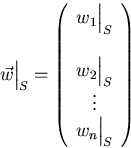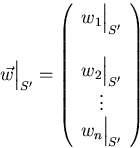Student request: change notations. Mine seem better than the book's, though.
Suppose I have a basis S, ![]() .Then any arbitrary vector
.Then any arbitrary vector ![]() can be written as
can be written as
![]()

Suppose I have another basis S', ![]() .Then the same vector
.Then the same vector ![]() can also be written as
can also be written as
![]()

The relationship between the two sets of coordinates is always
![]()
Please note that this use of language is confusing: while P is called the transformation matrix from S to S', it really takes coordinates from S' and converts them to coordinates in S. Just the opposite of what you would expect.
In still other words, if you assume S is an ``old'' basis, and S' is a ``new'' basis you want to switch to, then the transformation matrix P from old to new really computes old coordinates from new ones. To get the new coordinates from the old ones, instead use Q=P-1 (the transformation matrix from new to old):
![]()
Matrix P takes the form:
![]()
Warning: I think the books exposition (p207-210) is very confusing, partly by not using vector symbols to indicate vectors versus coordinates. I suggest you stick with my exposition above.